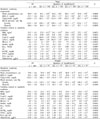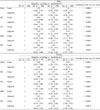1. Beach KW, Stransness DE Jr. Arteriosclerosis obliterans and associated risk factors in insulin-dependent and non-insulin-dependent diabetes. Diabetes. 1980. 29:882–888.

2. Krolewski AS, Kosinski EJ, Warram JH, Leland OS, Busick EJ, Asmal AC. Magnitude and determinations of coronary artry disease in juvenile onset, insulin dependent diabetes mellitus. Am J Cardiol. 1987. 59:750–755.
3. Alexander CM, Landsman PB, Teutsch SM, Haffner SM. NCEP-definedmetabolic syndrome, diabetes, and prevalence of coronary heart disease among NHANES III participants age 50years and older. Diabetes. 2003. 52:1210–1214.
4. Wilson PW, D'Agostino RB, Parise H, Sullivan L, Meigs JB. Metabolic syndrome as a precursor of cardiovascular disease and type 2 diabetes mellitus. Circulation. 2005. 112:3066–3072.

5. Park HS, Park CY, Oh SW, Yoo HJ. Prevalence of obesity and metabolic syndrome in Korean adults. Obes Rev. 2008. 9:104–107.

6. Park HS, Kim SM, Lee JS, Lee J, Han JH, Yoon DK, Baik SH, Choi DS, Choi KM. Prevalence and trends of metabolic syndrome in Korea: Korean National Health and Nutrition Survey 1998-2001. Diabetes Obes Metab. 2007. 9:50–58.

7. Korea Institute of Health and Social Affairs. The Third Korea National Health and Nutrition examination survey (KNHANES III), Korea. 2005. Seoul: Korea Ministry of Health and Welfare.
8. Kim WY, Kim JE, Choi YJ, Huh KB. Nutritional risk and metabolic syndrome in Korean type 2 diabetes mellitus. Asia Pac J Clin Nutr. 2008. 17:47–51.
9. Walldius G, Jungner I, Holme I, Astveit AH, Kolar W, Steiner E. High apolipoprotein B, low apolipoprotein A-I, and improvement in the prediction of fatal myocardial infarction(AMORIS study): a prospective study. Lancet. 2001. 358:2026–2033.
10. Sierra-Johnson J, Somers VK, Kuniyoshi FH, Garza CA, Isley WL, Gami AS, Lopez-Jimenez F. Comparison of apolipoprotein-B/apolipoprotein-AI in subjects with versus without the metabolic syndrome. Am J Cardiol. 2006. 98:1369–1373.

11. Alfadda AA, Al-Daghri NM, Malabu UH. Apolipoprotein B/apolipoprotein A-I ratio in relation to various definitions of metabolic syndrome among Saudi patients with type 2 diabetes mellitus. Saudi Med J. 2008. 29:821–825.
12. Reinhart RA, Gani K, Arndt MG, Broate ST. Apolipoprotein A-I and B as predictors of angiographically defined coronary artery disease. Arch Intern Med. 1990. 150:1629–1633.
13. Walldius G, Jungner I. The apoB/A-I ratio: a strong, new risk factor for cardiovascular disease and a target for lipid-lowering therapy- a review of the evidence. J Intern Med. 2006. 259:493–519.
14. Parenti M, Babini AC, Cecchetto ME, Di Bartolo P, Luchi A, Saretta B, Sorrenti G, Motta R, Melchionda N, Barbara L. Lipid, lipoprotein, and apolipoprotein assessment during an 8-wk very-low-calorie diet. Am J Clin Nutr. 1992. 56:268–270.

15. Watts GF, Chan DC, Ooi EMM, Nestel PJ, Beilin LJ, Barrett PH. Fish oils, phytosterols and weight loss in the regulation of lipoprotein transport in the metabolic syndrome: Lessons from stable isotope tracer studies. Clin Exp Pharmacol Physiol. 2006. 33:877–882.

16. Matthan NR, Welty FK, Barrett PHR, Dolnikowski GG, Park JS, Eckel RH, Schaefer EJ, Linhtenstein AH. Dietaryhydrogenated fat increase high-density lipoprotein apoA-I catabolism and decreases low-density lipoprotein apoB-100 catabolism in hypercholesterolemic women. Arterioscler Thromb Vasc Biol. 2004. 24:1092–1097.
17. Oh SY, Kim EM, Shin MH, Lee SH, Kim JE, Lee HS, Jo JS, Kim WY. Development and validity of food frequency questionnaire for adults. 2007. In : Proceedings of the Annual Spring Conference; The Korean Society of Health Promotion: Seoul, Korea.
18. Jiang R, Schulze MB, Li T, Rifai N, Stampfer MJ, Rimm EB, Hu FB. Non-HDL cholesterol and apolipoprotein B predict cardiovascular disease events among men with type 2 diabetes. Diabetes Care. 2004. 27:1991–1997.

19. Lee KH, Son JC, Kim BT, Choi BH, Hye JS, Cha CK, Choi JY, Lee YJ, Ahn YH. Non-HDL cholesterol as a risk factors of metabolic syndrome in Korean women. Atherosclerosis. 2005. 197:333–338.
20. Sniderman AD, Faraj M. Apolipoprotein B, apolipoprotein A-I, insulin resistance and the metabolic syndrome. Curr Opin Lipidol. 2007. 18:633–637.

21. Wallenfeldt K, Bokemark L, Wikstrand J, Hulthe J, Fagerberg B. Apolipoprotein B/apolipoprotein A-I in relation to the metabolic syndrome and change in carotid artery intima-media thickness during 3 years in middle-aged men. Stroke. 2004. 35:2248–2252.

22. Sattar N, Williams K, Sniderman AD, D'Agostino R Jr, Haffner SM. Comparison of the associations of apolipoprotein B and non-high-density lipoprotein cholesterol with other cardiovascular risk factors in patients with the metabolic syndrome in the Insulin Resistance Atherosclerosis Study. Circulation. 2004. 110:2687–2693.

23. Woo SK. Effect of Visceral Adipose Tissue on Atherogenic Lipoprotein-lipids in Circulating Plasma. Korean Journal of Exercise Nutrition. 2004. 8:303–308.
24. Godsland IF, Johnston DG, Chaturvedi N. Mechanisms of Disease: lessons from ethnicity in the role of triglyceride metabolism in ischemic heart disease. Nat Clin Pract Endocrinol Metab. 2007. 3:530–538.

25. Faraj M, Messier L, Bastard JP, Tardif A, Godbout A, Prud'homme D, Rabasa-Lhoret R. Apolipoprotein B: a predictor of inflammatory status in postmenopausal overweight and obese women. Diabetologia. 2006. 49:1637–1646.

26. Festa A, Hanley AJ, Tracy RP, D'Agostino R Jr, Haffner SM. Inflammation in the prediabetic state is related to increased insulin resistance rather than decreased insulin secretion. Circulation. 2003. 108:1822–1830.

27. Pradhan A. Obesity, metabolic syndrome, and type 2 diabetes: inflammatory basis of glucose metabolic disorders. Nutr Rev. 2007. 65:S152–S156.

28. Mehdi R, Asadollah MK. Interactions of serum hsCRP with apoB, apoB/AI ratio and some components of metabolic syndrome amplify the predictive values for coronary artery disease. Clin Biochem. 2006. 39:971–977.
29. Smith J, Al-Amri M, Sniderman A, Cianflone K. Leptin and adiponectin in relation to body fat percentage, waist to hip ratio and the apoB/apoA1 ratio in Asian Indian and Caucasian men and women. Nutr Metab. 2006. 10:18–25.

30. Yang EJ, Kim WY. The influence of dietary factors on the incidence of non-insulin-dependent diabetes mellitus. Korean J Nutr. 1999. 32:407–418.
31. Yu SY, Hong HS, Lee HS, Choi YJ, Huh KB, Kim WY. The association of insulin resistance with cardiovascular disease risk and dietary factors in Korean type 2 DM patients. Korean J Nutr. 2007. 40:31–40.







 PDF
PDF ePub
ePub Citation
Citation Print
Print



 XML Download
XML Download